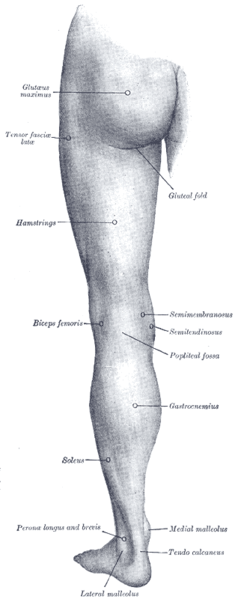Hamstring Stretches and Exercises for Flexibility
The purpose of this section is to cover the basics of the hamstrings and proper flexibility for that muscle group. If you want your body to function optimally hamstring flexibility should be a focus.
What is the hamstring?
The hamstring is the muscle group behind the thigh area. Three muscles make up the hamstrings. They are biceps femoris, semimembranosus, and semitendonosus. The hamstring muscle crosses two joints. It extends from the top of the tibia up to the pelvis.
Function
As it relates to real life most people probably look at the hamstring muscle as a leg flexor. Leg flexing is accomplished by bending the lower leg up towards the hamstring. But is that how itís generally used in real life? I donít think so. The hamstring is mostly used as a hip extensor. To understand hip extension visualize the movement of the leg backward during walking and running. What movements do we do all the time? Walk and run. These movements are powered by the hamstrings and glutes. Keep this function in mind as you design a hamstring strength training routine as well.
accomplished by bending the lower leg up towards the hamstring. But is that how itís generally used in real life? I donít think so. The hamstring is mostly used as a hip extensor. To understand hip extension visualize the movement of the leg backward during walking and running. What movements do we do all the time? Walk and run. These movements are powered by the hamstrings and glutes. Keep this function in mind as you design a hamstring strength training routine as well.
Generally speaking you want your Glute Maximus to be the prime mover in the case of running and walking. If you find your hamstring doing too much of the work you might be suffereing from Glute Amnesia. This means we need to wake up that muscle. Failure to wake up the glutes leads to injury and overcompensation of the hamstrings.
What basic movements and exercises use the Hamstring muscle
- Walk
- Run
- Jump
- Squat
- Lunges
- Leg Curl
- Hip Extension movements listed above
Why Stretch the hamstrings?
The easy answer is for optimal function and prevention of injuries. Poor hamstring flexibility can lead to compensations in other areas of the body. This can lead to injury. Proper hamstring flexibility leads to proper functioning of the body. This leads to muscles doing what they are supposed to do when called on to do it.
Who should stretch the hamstrings?
Almost everyone should stretch the hamstrings. Of course there are exceptions to the rule. People with major injury, possibly some eldery people with major cases of osteoporosis should not stretch. If you are concerned or question if stretching your hamstring is for you, consult with a medical professional before proceeding.
What are the different Hamstring Stretches?
Here are some good examples of stretches broken up into a few different categories: These exercises will be added later to the website.
Dynamic Stretching
Static Stretching
| Hamstring Static Stretch | |
 |
Exercise Description: Bend on the rear leg as seen. Bend forward with your back
straight until you feel a stretch in the hamstring of the leg
extended forward. |
Foam Rolling
| Hamstring Foam Roll Stretch | |
Exercise Description: |
|

